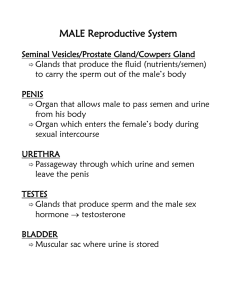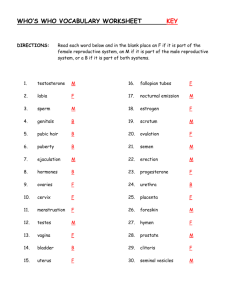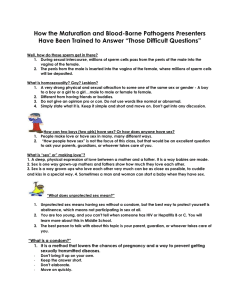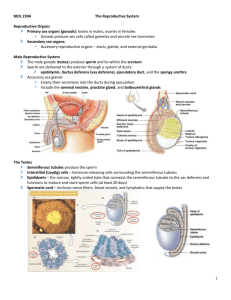The Reproductive System Lab 10
advertisement
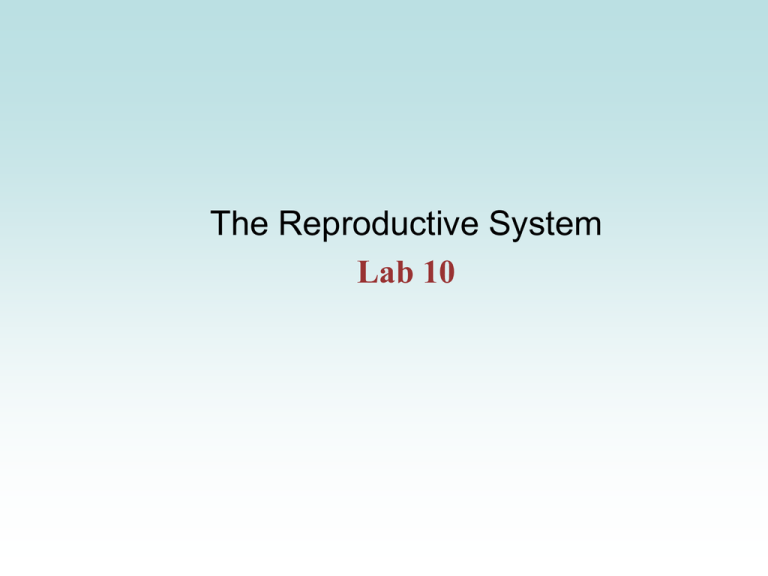
The Reproductive System Lab 10 Reproductive System • Primary sex organs (gonads) – testes in males, ovaries in females • Gonads produce sex cells called gametes and secrete sex hormones • Accessory reproductive organs – ducts, glands, and external genitalia • Sex hormones – androgens (males), and estrogens and progesterone (females) Reproductive System • Sex hormones play roles in: – The development and function of the reproductive organs – Sexual behavior and drives – The growth and development of many other organs and tissues Male Reproductive System • The male gonads (testes) produce sperm and lie within the scrotum • Sperm are delivered to the exterior through a system of ducts: epididymis, ductus deferens, ejaculatory duct, and the urethra • Accessory sex glands: – Empty their secretions into the ducts during ejaculation – Include the seminal vesicles, prostate gland, and bulbourethral glands The Scrotum • Sac of skin and superficial fascia that hangs outside the abdominopelvic cavity at the root of the penis • Contains paired testicles separated by a midline septum • Its external positioning keeps the testes 3C lower than core body temperature (needed for sperm production) The Scrotum Figure 27.2 The Testes • Each testis is surrounded by two tunics: – The tunica vaginalis, derived from peritoneum – The tunica albuginea, the fibrous capsule of the testis • Septa divide the testis into 250-300 lobules, each containing 1-4 seminiferous tubules The Testes • Seminiferous tubules: – Produce the sperm – Converge to form the tubulus rectus • The straight tubulus rectus conveys sperm to the rete testis The Testes • From the rete testis, the sperm: – Leave the testis via efferent ductules – Enter the epididymis • Surrounding the seminiferous tubules are interstitial cells that produce androgens The Testes Figure 27.3a The Penis • A copulatory organ designed to deliver sperm into the female reproductive tract • Consists of an attached root and a free shaft that ends in the glans penis • Prepuce, or foreskin – cuff of skin covering the distal end of the penis – Circumcision – surgical removal of the foreskin after birth The Penis • Internal penis – the urethra and three cylindrical bodies of erectile tissue • Erectile tissue – spongy network of connective tissue and smooth muscle riddled with vascular spaces The Penis Figure 27.4 Epididymis • Its head joins the efferent ductules and caps the superior aspect of the testis • The duct of the epididymis has stereocilia that: – Absorb testicular fluid – Pass nutrients to the sperm • Nonmotile sperm enter, pass through its tubes and become motile • Upon ejaculation the epididymis contracts, expelling sperm into the ductus deferens Accessory Glands: Seminal Vesicles • Lie on the posterior wall of the bladder and secrete 60% of the volume of semen – Semen – viscous alkaline fluid containing fructose, ascorbic acid, coagulating enzyme (vesiculase), and prostaglandins • Join the ductus deferens to form the ejaculatory duct • Sperm and seminal fluid mix in the ejaculatory duct and enter the prostatic urethra during ejaculation Accessory Glands: Prostate Gland • Doughnut-shaped gland that encircles part of the urethra inferior to the bladder • Its milky, slightly acid fluid, which contains citrate, enzymes, and prostate-specific antigen (PSA), accounts for one-third of the semen volume • Plays a role in the activation of sperm • Enters the prostatic urethra during ejaculation Accessory Glands: Bulbourethral Glands (Cowper’s Glands) • Pea-sized glands inferior to the prostate • Produce thick, clear mucus prior to ejaculation that neutralizes traces of acidic urine in the urethra Semen • Milky white, sticky mixture of sperm and accessory gland secretions • Provides a transport medium and nutrients (fructose), protects and activates sperm, and facilitates their movement • Prostaglandins in semen: – Decrease the viscosity of mucus in the cervix – Stimulate reverse peristalsis in the uterus – Facilitate the movement of sperm through the female reproductive tract Semen • The hormone relaxin enhances sperm motility • The relative alkalinity of semen neutralizes the acid environment found in the male urethra and female vagina • Seminalplasmin – antibiotic chemical that destroys certain bacteria • Clotting factors coagulate semen immediately after ejaculation, then fibrinolysin liquefies the sticky mass • Only 2-5 ml of semen are ejaculated, but it contains 50-130 million sperm/ml Comparison of Mitosis and Meiosis Figure 27.6 Hormonal Regulation of Testicular Function • Feedback inhibition on the hypothalamus and pituitary results from: – Rising levels of testosterone – Increased inhibin Figure 27.10 Mechanism and Effects of Testosterone Activity • Testosterone is synthesized from cholesterol • It must be transformed to exert its effects on some target cells – Prostate – it is converted into dihydrotestosterone (DHT) before it can bind within the nucleus – Neurons – it is converted into estrogen to bring about stimulatory effects • Testosterone targets all accessory organs and its deficiency causes these organs to atrophy • Testosterone is the basis of libido in both males and females Female Reproductive Anatomy • Ovaries are the primary female reproductive organs – Make female gametes (ova) – Secrete female sex hormones (estrogen and progesterone) • Accessory ducts include uterine tubes, uterus, and vagina • Internal genitalia – ovaries and the internal ducts • External genitalia – external sex organs Female Reproductive Anatomy Figure 27.11 The Ovaries • Paired organs on each side of the uterus held in place by several ligaments – Ovarian lig.– anchors the ovary medially to the uterus – Suspensory lig. – anchors the ovary laterally to the pelvic wall – Mesovarium lig.– suspends the ovary in between • Broad ligament – contains the suspensory ligament and the mesovarium The Ovaries Figure 27.14a Ovaries • Blood supply – ovarian arteries and the ovarian branch of the uterine artery • They are surrounded by a fibrous tunica albuginea, which is covered by a layer of epithelial cells called the germinal epithelium • Embedded in the ovary cortex are ovarian follicles Ovaries • Each follicle consists of an immature egg called an oocyte • Cells around the oocyte are called: – Follicle cells (one cell layer thick) – Granulosa cells (when more than one layer is present) Ovaries • Primordial follicle – one layer of squamouslike follicle cells surrounds the oocyte • Primary follicle – two or more layers of cuboidal granulosa cells enclose the oocyte • Secondary follicle – has a fluid-filled space between granulosa cells that coalesces to form a central antrum Ovaries • Graafian follicle – secondary follicle at its most mature stage that bulges from the surface of the ovary • Ovulation – ejection of the oocyte from the ripening follicle • Corpus luteum – ruptured follicle after ovulation Ovaries Figure 27.12 Uterine Tubes (Fallopian Tubes) and Oviducts • Receive the ovulated oocyte and provide a site for fertilization • Empty into the superolateral region of the uterus via the isthmus • Expand distally around the ovary forming the ampulla • The ampulla ends in the funnel-shaped, ciliated infundibulum containing fingerlike projections called fimbriae Uterine Tubes • The uterine tubes have no contact with the ovaries and the ovulated oocyte is cast into the peritoneal cavity • Beating cilia on the fimbriae create currents to carry the oocyte into the uterine tube • The oocyte is carried toward the uterus by peristalsis and ciliary action Uterus • Hollow, thick-walled organ located in the pelvis anterior to the rectum and posterosuperior to the bladder • Body – major portion of the uterus • Fundus – rounded region superior to the entrance of the uterine tubes • Isthmus – narrowed region between the body and cervix Uterus • Cervix – narrow neck which projects into the vagina inferiorly • Cervical canal – cavity of the cervix that communicates with: – The vagina via the external os – The uterine body via the internal os • Cervical glands secrete mucus that covers the external os and blocks sperm entry except during midcycle Supports of the Uterus • Mesometrium – portion of the broad ligament that supports the uterus laterally • Lateral cervical ligaments – extend from the cervix and superior part of the vagina to the lateral walls of the pelvis • Uterosacral ligaments – paired ligaments that secure the uterus to the sacrum • Round ligaments – bind the anterior wall to the labia majora Uterine Wall • Composed of three layers – Perimetrium – outermost serous layer; the visceral peritoneum – Myometrium – middle layer; interlacing layers of smooth muscle – Endometrium – mucosal lining of the uterine cavity Uterine Wall Figure 27.15b Endometrium • Has numerous uterine glands that change in length as the endometrial thickness changes • Stratum functionalis: – Undergoes cyclic changes in response to ovarian hormones – Is shed during menstruation • Stratum basalis: – Forms a new functionalis after menstruation ends – Does not respond to ovarian hormones Vagina • Thin-walled tube lying between the bladder and the rectum, extending from the cervix to the exterior of the body • The urethra is embedded in the anterior wall • Provides a passageway for birth, menstrual flow, and is the organ of copulation Vagina • Wall consists of three coats: fibroelastic adventitia, smooth muscle muscularis, and a stratified squamous mucosa • Mucosa near the vaginal orifice forms an incomplete partition called the hymen • Vaginal fornix – upper end of the vagina surrounding the cervix Vagina Figure 27.16 External Genitalia: Vulva (Pudendum) • Lies external to the vagina and includes the mons pubis, labia, clitoris, and vestibular structures • Mons pubis – round, fatty area overlying the pubic symphysis • Labia majora – elongated, hair-covered, fatty skin folds homologous to the male scrotum • Labia minora – hair-free skin folds lying within the labia majora; homologous to the ventral penis External Genitalia: Vulva (Pudendum) • Greater vestibular glands – Pea-size glands flanking the vagina – Homologous to the bulbourethral glands – Keep the vestibule moist and lubricated External Genitalia: Vulva (Pudendum) • Clitoris (homologous to the penis) – Erectile tissue hooded by the prepuce – The exposed portion is called the glans • Perineum – Diamond-shaped region between the pubic arch and coccyx – Bordered by the ischial tuberosities laterally Mammary Glands • Modified sweat glands consisting of 15-25 lobes that radiate around and open at the nipple • Areola – pigmented skin surrounding the nipple • Suspensory ligaments attach the breast to underlying muscle fascia • Lobes contain glandular alveoli that produce milk in lactating women • Compound alveolar glands pass milk to lactiferous ducts, which open to the outside Structure of Lactating Mammary Glands Figure 27.17 Breast Cancer: Detection and Treatment • Early detection is by self-examination and mammography • Treatment depends upon the characteristics of the lesion • Radiation, chemotherapy, and surgery followed by irradiation and chemotherapy • Today, lumpectomy is the surgery used rather than radical mastectomy

